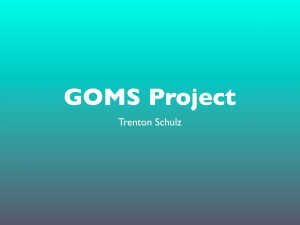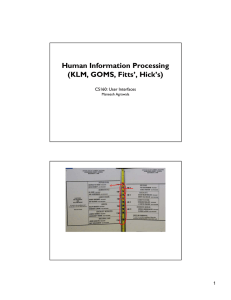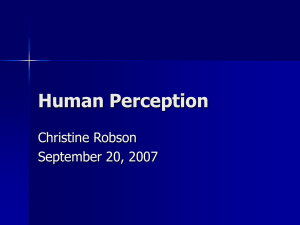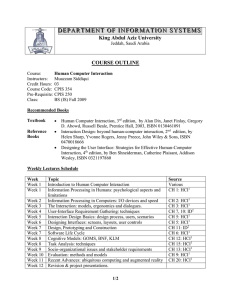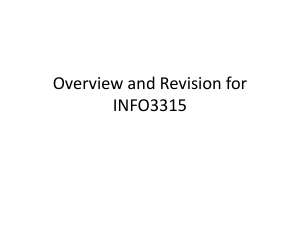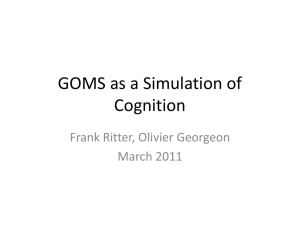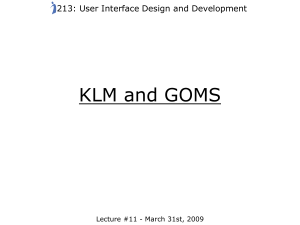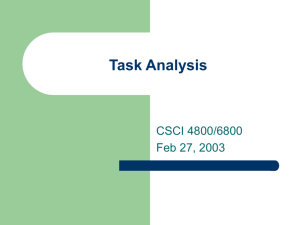Evaluation Types GOMS and KLM CS352
advertisement
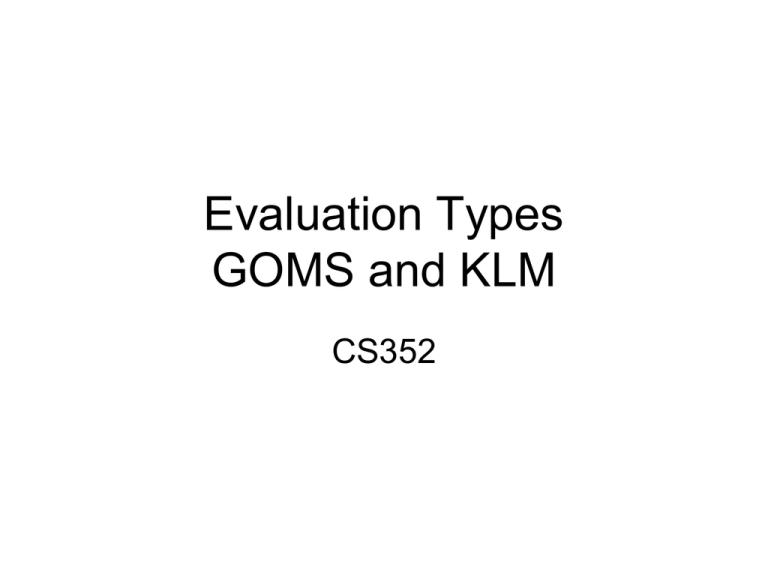
Evaluation Types GOMS and KLM CS352 Announcements • Mid-term Tue of Week 5 • Project presentations – Your users (before mid-term) • Next milestone of you project will be out later today or tomorrow (Prototypes) • Reading – 12.3 (evaluation methods), 15.4 (GOMS) 2 Where we are in PRICPS: • Predispositions: Did this in Project Proposal. • RI: Research was studying users. Hopefully led to Insights. • CP: Concept and initial (very low-fi) Prototypes due some time next week • Evaluate throughout, repeat iteratively!! Evaluation • Analytical – based on your head • Empirical – based on data – Formative • inFORMs design • what is (still) needed? – Summative • did it work? Analytical methods • You follow established guidelines/procedures/models to decide (in your head) how good your design is. • Examples: – GOMS/KLM – for skilled users, no errors. • evaluating efficiency of regular use. – Heuristic Evaluation – Cognitive Walkthrough – for first-time users. • evaluating ease of learning. GOMS (and KLM) • GOMS: a family of models. • Predict user performance. • Useful for predicting actual time a user will take in UI. • Useful for comparing different UIs. GOMS Constructs • • • • Goal, Operators, Methods, Selection rules Goal: “what”. Method: “how” steps (learned). Operators: Cognitive processes + physical actions to DO it. • Selection rules: rules saying which method to select. GOMS example: Delete a word • Goal: delete a word in a sentence. • Method #1: use the menu – Recall that the word has to be highlighted. – Recall that the command is “cut”. – Recall that “cut” is in the Edit Menu. – Accomplish goal of selecting and executing “cut”. – Return: goal accomplished. GOMS example (cont.) • Method #2: use the delete key – Recall where to position cursor in relation to word to be deleted. – Recall which key is delete key. – Press “delete” key to delete each letter. – Return: goal accomplished. • Operators used in these methods – Click mouse, Drag cursor over text, Select menu, Move cursor, Press KB key, Recall, ... GOMS example (cont.) • Selection rules: – Use mouse/menu method (#1) if there’s a lot of text to delete. – Else use “delete” key (method #2). Applications of GOMS • Various application and fields – Telephone operator workstation using CPMGOMS – CAD system for ergonomic design using NGOMSL – Intelligent tutoring system using NGOMSL – Mouse driven text editor using KLM – Bank deposit reconciliation system using KLM – Space operations database system using KLM Telephone operator workstation using CPM-GOMS • The task: a telephone company operator responding to customer requests for assistance. Limitations of GOMS [Card et al. (1980) ] • applied to skilled users, not to beginners or intermediates. • doesn't account for either learning of the system or its recall after a period of disuse. • doesn't account for errors. • does not address the amount and kind of fatigue • individual differences among users is not accounted for in the model. KLM (a low-level variant of GOMS) • Keystroke Level Model. • Simple, but accurate. Widely used. • Scope: – skilled users – doing a task error-free. – using a specific method in a UI. • CogTool has this built-in. KLM Operators • User Operators: – K (keystroke), P (point), H (homing), D (drawing), M (mental: think). – Times for each are provided to you • based on extensive research/empirical data. • System Operator: – R (respond). KLM/GOMS example 1: Open a file • 27 ways to open a file in Windows! • Methods as states + transitions. • (High op granularity combines low-level ops.) KLM/GOMS example 1 (cont.) • Used to: – Understand cost of each. – (break down participants actual costs). – “RL”:recent lists. – “WS/WX”:search. • And to... KLM/GOMS example 1 (cont.) • Use the breakdowns to compare costs to new UI alternative (new feature “FP”) actual calc’d Hick’s Law • GOMS’s “S” stands for “Selection” • Hick’s Law predicts the time to make a choice between multiple choices, n is the # of choices: Fitts’ Law • Predicts that the time required to rapidly move to a target area is a function of the distance to and the size of the target In practice… • GOMS not used often • Fitts’ law often used for determining best case for new kinds of input methods CogTool Example • CogTool examples. – Calculating the cost of the task in this UI. – Comparing the cost if do the task with different widgets. – Where are these cost differences coming from? • under the hood to ACT/R What’s coming up next: • Heuristic Evaluation • Cognitive Walkthroughs • Empirical Studies
